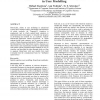784 search results - page 11 / 157 » What would they think |
IUI
1997
ACM
13 years 11 months ago
1997
ACM
Historically, efforts at user modelling in educational systems have tended to employ knowledge representations in which symbolic (or "linguistic") cognition is emphasize...
DIGRA
2005
Springer
14 years 1 months ago
2005
Springer
Game studies methodologies which focus on the visual, narrative, and semiotic content of digital games overlook the way that embodied perception and physiological response contrib...
WSC
1997
13 years 9 months ago
1997
The paper describes a simulation substrate that allows thinking agents to interact with a world. The world is simulated by standard discrete event simulation, but the timing of an...
ISORC
2000
IEEE
14 years 23 hour ago
2000
IEEE
The Air Force has enthusiastically endorsed, at its most senior levels, advanced thinking with regard to the application of information technology. Recently, the notion of a Joint...
ICSM
2002
IEEE
14 years 17 days ago
2002
IEEE
Software is multidimensional but the tools that support it are not. The lack of tool support causes the software artifacts representing different dimensions to evolve independentl...

